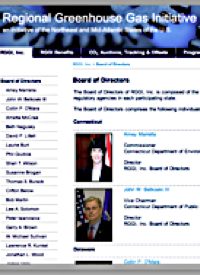
While Americans were battling cap-and-trade legislation at the national and international levels, global-warming alarmists were quietly building regional systems between state and local governments, private industry, and even foreign governments that basically achieve the same effect — higher energy prices for consumers and more money for governments.
The first and most prominent of these U.S. cap-and-trade systems is known as the Regional Greenhouse Gas Initiative (RGGI). It was created not by the people through their legislatures, but by a so-called Memorandum of Understanding between state governors.
Consisting so far of 10 Northeastern and mid-Atlantic states Connecticut, Delaware, Maine, Maryland, Massachusetts, New Hampshire, New Jersey, New York, Rhode Island, and Vermont the scheme is described on the RGGI website as the first mandatory, market-based effort in the United States to reduce greenhouse gas emissions. Its board of directors consists primarily of each participating states top environmental bureaucrats.
The Initiative works by having each state cap its carbon dioxide emissions at a certain level, then auctioning off emissions permits to the highest bidder. Eventually, the CO2 limits will be reduced, causing increased energy prices as companies pass along the added costs to consumers. By 2018, the RGGI plans to reduce energy-sector emissions by 10 percent.
Thus far, the scheme has netted close to a billion dollars by selling carbon credits to utility companies and other firms in participating states, earning about $50 million through an auction held on December 1. The first auction was actually held in 2008, and there have been nine since then. Spoils from the emissions permits are then handed out by state governments to companies, environmental groups, and others.
Incredibly, the RGGI has managed to avoid public scrutiny of its operations by incorporating as a non-profit organization and leaving enforcement and regulation to the individual states. The corporation claims it does not have to respond to public requests for information since, technically, it is not actually a government entity.
But the corruption is already coming out in the open. New Hampshire conservationists had high hopes for how $18 million in funding generated by the Regional Greenhouse Gas Initiative (RGGI) might advance energy efficiency projects, wrote columnist Fergus Cullen in the New Hampshire Union Leader earlier this year. Unfortunately, cronyism and corporate welfare hallmark too many grants awarded by the Public Utilities Commission so far.
Cullens piece details, among other things, the outrageous handouts to environmental front groups and big businesses that helped push the scheme through. For example, an activist group in New Hampshire called Clean Air Cool Planet was incorporated by out-of-state bigwigs to promote global-warming alarmism including Al Gores discredited documentary, An Inconvenient Truth.
Having helped create this pot of money, Clean Air was one of the first in line with its hand out so it can do more alarmist advocacy, paid for with public resources awarded by friends, Cullen explains. The group has already received almost half of a million dollars. Another example cited by the columnist: Yogurt on a mission producer Stonyfield Farm, with $300 million in yearly sales, received nearly $150,000 to upgrade its air-conditioning system.
Money was basically shoveled out, creating opportunities for the well-connected and the in-the-know while millions of dollars have gone out the window, wasted like heat leaking out of an uncaulked pane, Cullen concludes.
But RGGI boss Jonathan Schrage who after intense public pressure recently disclosed his salary of almost $170,000 per year thinks the scheme is great. I look forward to building RGGI Inc. into a dependable administrative ally of each states RGGI program, Schrag said in a press release when he was appointed executive director. The states have done tremendous work to develop the first CO2 cap-and-trade system in the U.S.
Not everyone thinks so, though. And in an e-mail to supporters, the Center for the Defense of Free Enterprise warned of even bigger problems to come. RGGI is the prototype for more regional cap & tax entities, wrote the organizations executive vice president Ron Arnold. Soon RGGI will expand to every state and stick you with astronomical energy prices.
Arnold blamed the corruptocrats in Washington for the gigantic waste of tax dollars, adding that the crooks behind RGGI must be exposed and held accountable. He also said that, despite RGGI claims that it is making a significant impact to combat the threat of global warming, the data proves otherwise.
The only impact RGGI has made so far is they have raised energy prices and created a slush fund for each member state, Arnold explained. And according to his letter, the fact that global warming isnt even real wont prevent the climate change scam from spreading to other states. And hes right its already happening.
An even bigger and more ambitious effort that includes Canadian provinces and even Mexican states as observers is set to go into effect in 2012. Known as the Western Climate Initiative, the scheme is described on its official website as a collaboration of independent jurisdictions working together to identify, evaluate, and implement policies to tackle climate change at a regional level.
Among the participating jurisdictions: California, Oregon, Washington, Arizona, Utah, New Mexico, Montana, and four Canadian provinces. So-called observers, jurisdictions that are likely to join soon, include six Mexican states, an additional six U.S. states, and another three Canadian provinces. The Western Climate Initiative, like the RGGI, was also created by an agreement between state governors not legislatures.
A similar scheme for the American Midwest, under the banner of the Midwestern Greenhouse Gas Reduction Accord, is also set to enter into force in 2012. The agreement encompasses Iowa, Illinois, Kansas, Manitoba, Michigan, Minnesota, and Wisconsin for now. Three other U.S. states and one additional Canadian province are listed on the schemes website as observers.
One unifying factor between all the regional partnerships is the emphasis on promoting expansion and eventual federal and even international involvement. And in Cancun at the global warming summit, state and local-government leaders made it clear that they would continue marching forward with the anti-carbon dioxide schemes at the global level no matter what the outcome of United Nations climate talks currently underway in Cancun.
“We are proving that while a global agreement is important, we do not need to wait for it to start building the path to a new low carbon future,” explained Quebec Premier Jean Charest, the co-chair of the States & Regions Alliance, during a summit at the COP16. “As our national counterparts meet here in Cancun to continue the negotiations, states and regions are continuing to show the leadership necessary to make practical headway on climate action.”
And this is all part of the broader global plan. The so-called States and Regions Alliance represented by Premier Charest some 60 state and regional governments accounting for about 15 percent of the worlds Gross Domestic Product is part of a shadowy but powerful international non-profit known as The Climate Group.
The organization works with the United Nations Development Program, the World Economic Forum, the Administrative Center for China’s Agenda 21, the U.S. Department of Energy, and other high-profile institutions, agencies and governments to advance the global climate agenda. And it promotes the implementation of global-warming schemes through sub-national levels of government among other things.
States, regions and cities are where the rubber hits the road in terms of practical action to reduce greenhouse gas emissions, wrote States and Regions Alliance co-chair and Quebec Premier Charest, along with his fellow co-chair, South Australia Premier Mike Rann.
The UN Development Program estimates that 50 per cent to 80 per cent of the emissions cuts needed to keep climate change below 2C will need to be delivered at state, regional and city levels, the co-chairs noted in their joint column for The Australian entitled Think globally, act locally? States already are. This is because regional governments often control regulation for many of the key areas for addressing climate change, such as power generation, the built environment, waste management, transport and land use planning.
CEO of The Climate Group Steve Howard offered a similar analysis. “A clean industrial revolution is not only possible, but it is well underway in the world’s leading states, cities and regions,” he told COP16 attendees at the Climate Leaders Summit in Cancun Wednesday. “The subnational governments in our Alliance are not waiting for a global agreement but are forging agreements of their own to lead a growing global market for low-carbon goods and services already estimated at $4.7 trillion.”
Despite the U.S. Senates rejection of cap-and-trade legislation, the carbon-tax agenda is still being implemented in America and around the world. Using the Environmental Protection Agency, the Obama administration is moving forward on regulating emissions of carbon dioxide at the federal level. And through alliances and agreements between states and even foreign governments unconstitutional under Article 1, Section 10 of the U.S. Constitution those same forces are building a powerful and expensive carbon regime that could eventually encompass every state in the Union, and beyond.
Related articles:
Skeptics Have Their Say at COP16, Press Refuses to Report
COP16 Attendees Sign Petition to Ban Water, Harm U.S.
Will EPA Admit Economic Impact of Regulations?
Climate “Experts” Propose Global One-child Policy, Socialism, Taxes, Carbon Rationing
WikiLeaks Reveals U.S. & EU Climate Bullying, Bribery, Espionage



